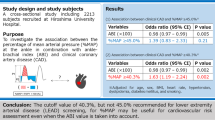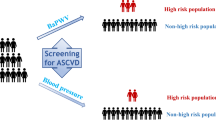Abstract
The score based on the office systolic blood pressure, age, fasting blood glucose level, and estimated glomerular filtration rate (SAGE score) has been proposed as a useful marker to identify elevated values of carotid-femoral pulse wave velocity (PWV). The present cross-sectional study was conducted to examine whether the SAGE score is also a useful marker to identify subjects with elevated brachial-ankle PWV values in Japanese subjects with hypertension. We measured the brachial-ankle PWV and calculated the SAGE score in a total of 1019 employees of a Japanese company with hypertension and 817 subjects with hypertension derived from a multicenter study cohort. The analyses in this study were based on data from these two study groups as well as on a composite population of the two (n = 1836). The receiver operating characteristic curve analysis showed that the area under the curve to identify subjects with brachial-ankle PWV values of ≥1800 cm/s was over 0.70 in each of the three study groups. Even after adjustments, a SAGE score ≥7 had a significant odds ratio for identifying subjects with brachial-ankle PWV values ≥1800 cm/s in the 1836 study subjects from the composite occupational and multicenter study cohort (odds ratio = 2.1, 95% confidence interval = 1.4–3.0, P < 0.01). Thus, in Japanese subjects with hypertension, the SAGE score may be a useful marker for identifying subjects with elevated brachial-ankle PWV values.
This is a preview of subscription content, access via your institution
Access options
Subscribe to this journal
Receive 12 print issues and online access
$259.00 per year
only $21.58 per issue
Buy this article
- Purchase on Springer Link
- Instant access to full article PDF
Prices may be subject to local taxes which are calculated during checkout

Similar content being viewed by others
References
Tomiyama H, Yamashina A. Non-invasive vascular function tests: their pathophysiological background and clinical application. Circ J 2010;74:24–33.
Safar ME. Arterial stiffness as a risk factor for clinical hypertension. Nat Rev Cardiol. 2018;15:97–105.
Yannoutsos A, Ahouah M, Dreyfuss Tubiana C, Topouchian J, Safar ME, et al. Aortic stiffness improves the prediction of both diagnosis and severity of coronary artery disease. Hypertens Res. 2018;41:118–25.
Cecelja M, Chowienczyk P. Dissociation of aortic pulse wave velocity with risk factors for cardiovascular disease other than hypertension: a systematic review. Hypertension 2009;54:1328–36.
Tomiyama H, Yamashina A, Arai T, Hirose K, Koji Y, Chikamori T, et al. Influences of age and gender on results of noninvasive brachial-ankle pulse wave velocity measurement-a survey of 12517 subjects. Atherosclerosis 2003;166:303–9.
Tomiyama H, Hirayama Y, Hashimoto H, Yambe M, Yamada J, Koji Y, et al. The effects of changes in the metabolic syndrome detection status on arterial stiffening: a prospective study. Hypertens Res 2006;29:673–8.
Satoh H, Kishi R, Tsutsui H. Metabolic syndrome is a significant and independent risk factor for increased arterial stiffness in Japanese subjects. Hypertens Res 2009;32:1067–71.
Reference Values for Arterial Stiffness’ Collaboration. Determinants of pulse wave velocity in healthy people and in the presence of cardiovascular risk factors: ‘establishing normal and reference values’. Eur Heart J. 2010;31:2338–50.
Haraguchi N, Koyama T, Kuriyama N, Ozaki E, Matsui D, Watanabe I, et al. Assessment of anthropometric indices other than BMI to evaluate arterial stiffness. Hypertens Res. 2019;42:1599–605.
Xaplanteris P, Vlachopoulos C, Protogerou AD, Aznaouridis K, Terentes-Printzios D, Argyris AA, et al. A clinical score for prediction of elevated aortic stiffness: derivation and validation in 3943 hypertensive patients. J Hypertens 2019;37:339–46.
Tomiyama H, Matsumoto C, Shiina K, Yamashina A. Brachial-Ankle PWV: current status and future directions as a useful marker in the management of cardiovascular disease and/or cardiovascular risk factors. J Atheroscler Thromb. 2016;23:128–46.
Ohkuma T, Ninomiya T, Tomiyama H, Kario K, Hoshide S, Kita Y, et al. Collaborative group for j-bavel (japan brachial-ankle pulse wave velocity individual participant data meta-analysis of prospective studies)*. brachial-ankle pulse wave velocity and the risk prediction of cardiovascular disease: an individual participant data meta-analysis. Hypertension 2017;69:1045–52.
Ohkuma T, Tomiyama H, Ninomiya T, Kario K, Hoshide S, Kita Y, et al. Collaborative Group for Japan brachial-ankle pulse wave velocity individual participant data meta-analysis of prospective studies (j-bavel). proposed cutoff value of brachial-ankle pulse wave velocity for the management of hypertension. Circ J 2017;81:1540–2.
Tomiyama H, Shiina K, Vlachopoulos C, Iwasaki Y, Matsumoto C, Kimura K, et al. Involvement of Arterial Stiffness and Inflammation in Hyperuricemia-Related Development of Hypertension. Hypertension 2018;72:739–45.
Tomiyama H, Komatsu S, Shiina K, Matsumoto C, Kimura K, Fujii M, et al. Effect of Wave Reflection and Arterial Stiffness on the Risk of Development of Hypertension in Japanese Men. J Am Heart Assoc. 2018;7:e008175 https://doi.org/10.1161/JAHA.117.008175.
Tomiyama H, Ishizu T, Kohro T, Matsumoto C, Higashi Y, Takase B, et al. Longitudinal association among endothelial function, arterial stiffness and subclinical organ damage in hypertension. Int J Cardiol. 2018;253:161–6. https://doi.org/10.1016/j.ijcard.2017.11.022
Tomiyama H, Kohro T, Higashi Y, Takase B, Suzuki T, Ishizu T, et al. A multicenter study design to assess the clinical usefulness of semi-automatic measurement of flow-mediated vasodilatation of the brachial artery. Int Heart J. 2012;53:170–5.
Motobe K, Tomiyama H, Koji Y, Yambe M, Gulinisa Z, Arai T, et al. Cut-off value of the ankle-brachial pressure index at which the accuracy of brachial-ankle pulse wave velocity measurement is diminished. Circ J 2005;69:55–60.
Horio M, Imai E, Yasuda Y, Watanabe T, Matsuo S. Modification of the CKD epidemiology collaboration (CKD-EPI) equation for Japanese: accuracy and use for population estimates. Am J Kidney Dis. 2010;56:32–8.
Levey AS, Stevens LA. Estimating GFR using the CKD Epidemiology Collaboration (CKD-EPI) creatinine equation: more accurate GFR estimates, lower CKD prevalence estimates, and better risk predictions. Am J Kidney Dis. 2010;55:622–7.
Townsend RR, Wilkinson IB, Schiffrin EL, Avolio AP, Chirinos JA, Cockcroft JR, et al. American heart association council on hypertension. recommendations for improving and standardizing vascular research on arterial stiffness: a scientific statement From the American Heart Association. Hypertension 2015;66:698–722.
Tanaka H, Munakata M, Kawano Y, Ohishi M, Shoji T, Sugawara J, et al. Comparison between carotid-femoral and brachial-ankle pulse wave velocity as measures of arterial stiffness. J Hypertens 2009;27:2022–7.
Ben-Shlomo Y, Spears M, Boustred C, May M, Anderson SG, Benjamin EJ, et al. Aortic pulse wave velocity improves cardiovascular event prediction: an individual participant meta-analysis of prospective observational data from 17,635 subjects. J Am Coll Cardiol. 2014;63:636–46.
Avolio AP, Kuznetsova T, Heyndrickx GR, Kerkhof PLM, Li JK. Arterial flow, pulse pressure and pulse wave velocity in men and women at various ages. Adv Exp Med Biol. 2018;1065:153–68.
Rezai MR, Wallace AM, Sattar N, Finn JD, Wu FC, Cruickshank JK. Ethnic differences in aortic pulse wave velocity occur in the descending aorta and may be related to vitamin D. Hypertension. 2011;58:247–53.
American Diabetes Association. Standards of medical care in diabetes-2019. Diabetes Care. 2019;42:S1–S193.
Funding
This study was partially supported financially by a Grant-in-Aid for scientific research from the Ministry of Health, Labour and Welfare, by the Japanese Atherosclerosis Prevention Research Fund (A study of Multi-center Assessment on the Clinical Usefulness of Semi-automatic Measurement of Flow-mediated Vasodilatation of the Brachial Artery: FMD-J study), and by the Omron Health Care Company, Kyoto, Japan.
Author information
Authors and Affiliations
Corresponding authors
Ethics declarations
Conflict of interest
The sponsor (Omron Health Care Company) assisted in the data formatting (i.e., the brachial-ankle pulse wave velocity data stored in the hard disc of the equipment used for measurement of the brachial-ankle pulse wave velocity was transferred to an Excel file); other than this, the company played no role in the design or conduct of the study, i.e., in the data collection, management, analysis or interpretation of the data, or in the preparation, review or approval of the manuscript.
Additional information
Publisher’s note Springer Nature remains neutral with regard to jurisdictional claims in published maps and institutional affiliations.
Supplementary information
Rights and permissions
About this article
Cite this article
Tomiyama, H., Vlachopoulos, C., Xaplanteris, P. et al. Usefulness of the SAGE score to predict elevated values of brachial-ankle pulse wave velocity in Japanese subjects with hypertension. Hypertens Res 43, 1284–1292 (2020). https://doi.org/10.1038/s41440-020-0472-7
Received:
Revised:
Accepted:
Published:
Issue Date:
DOI: https://doi.org/10.1038/s41440-020-0472-7



